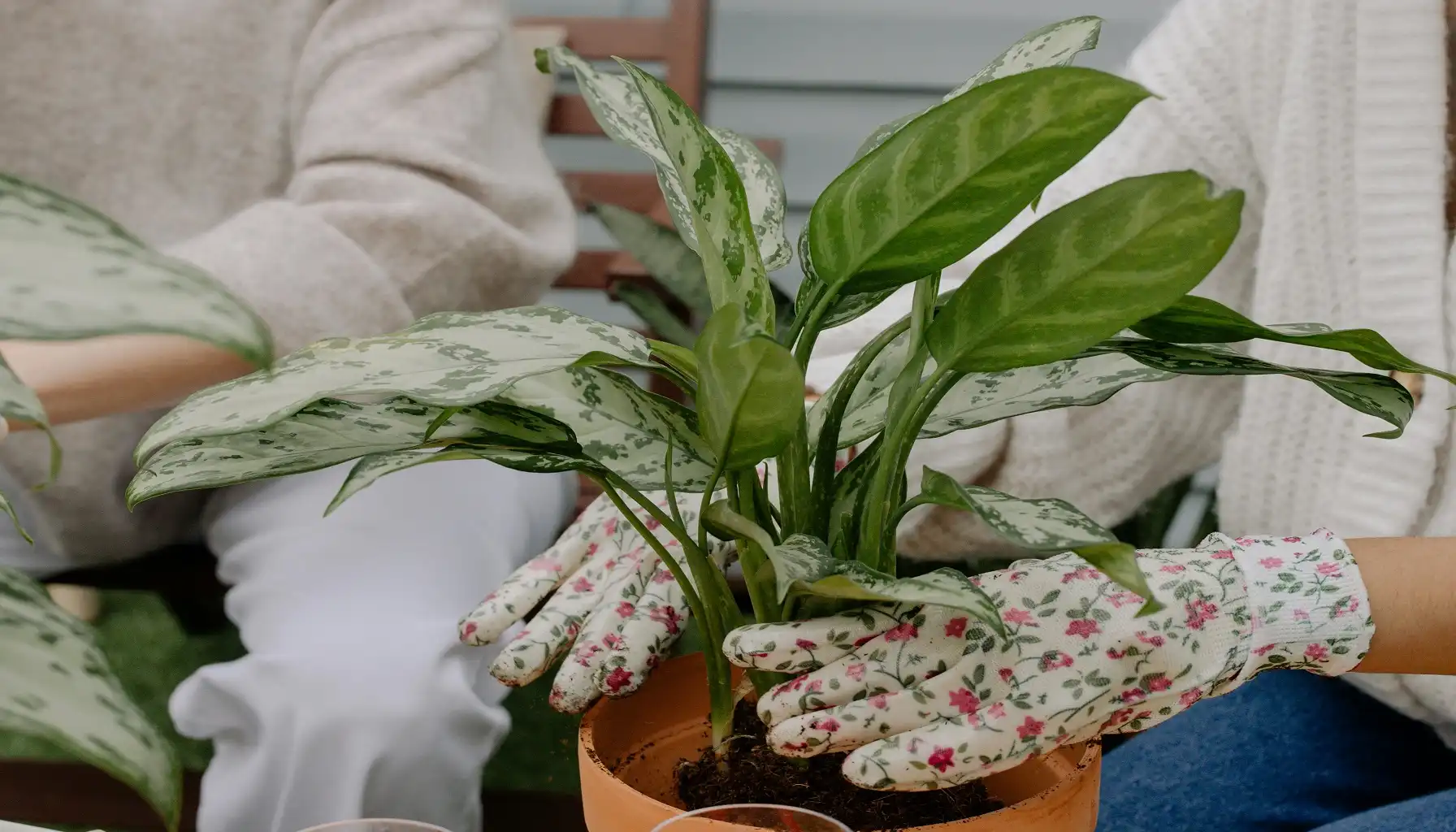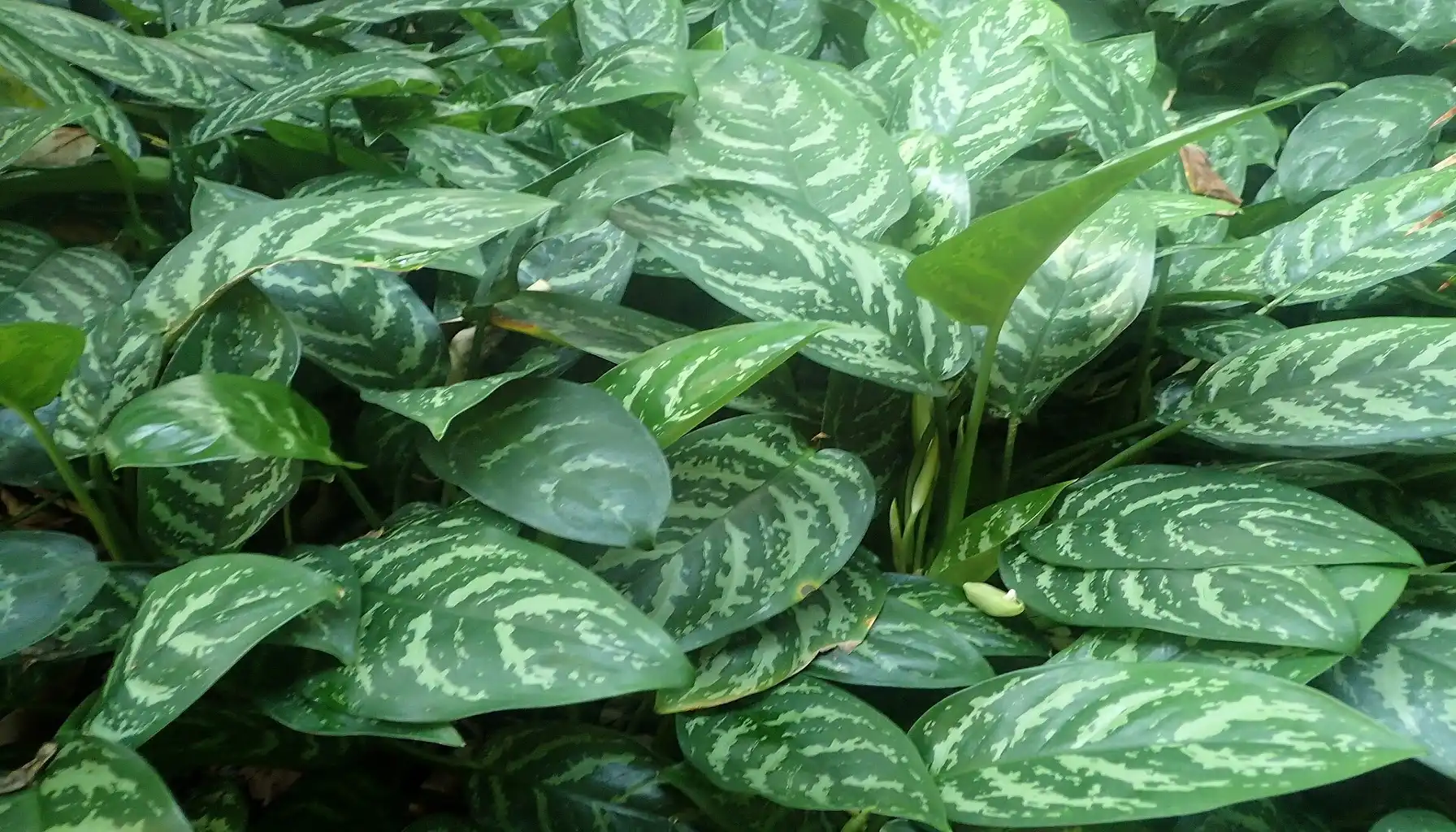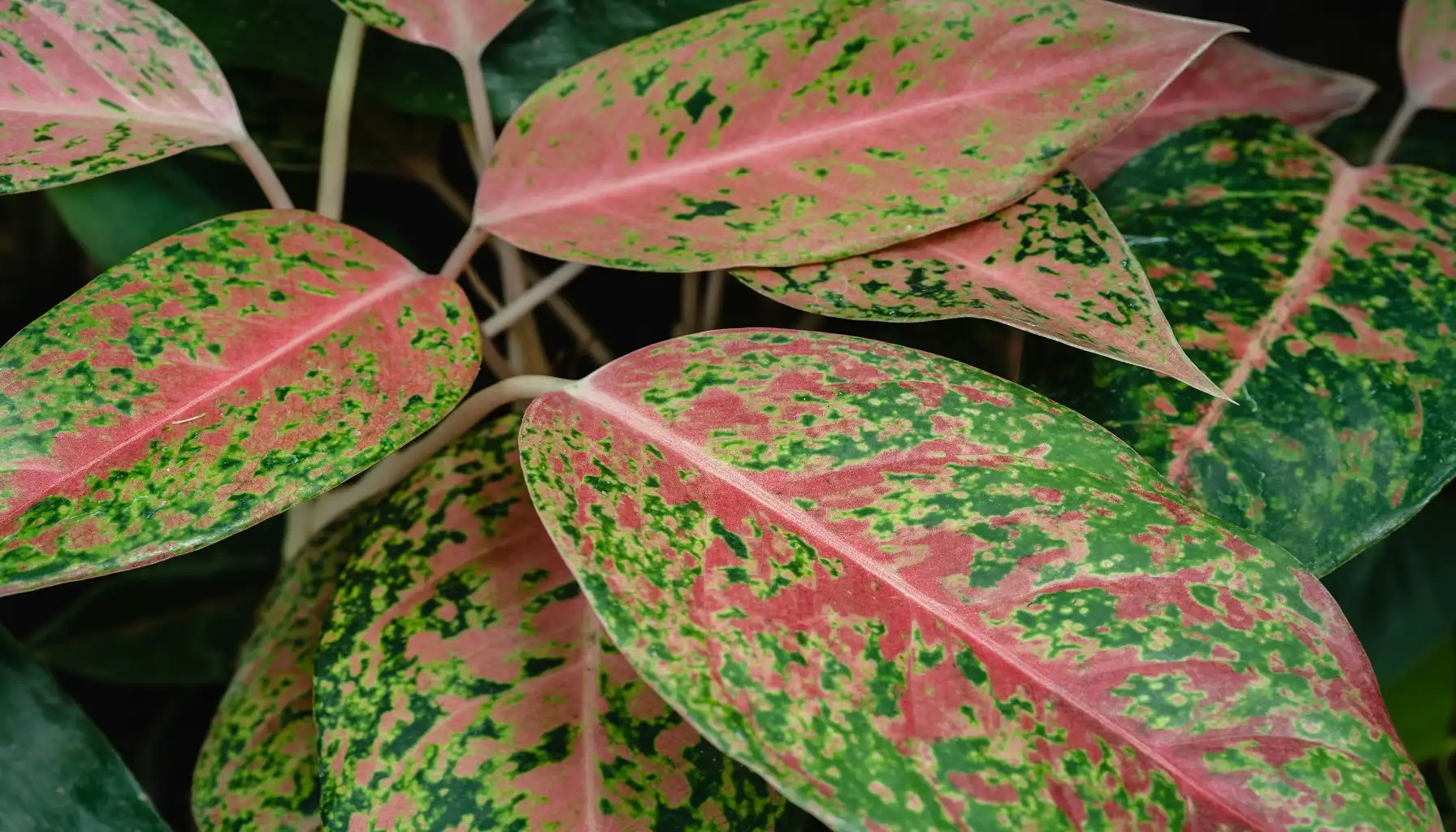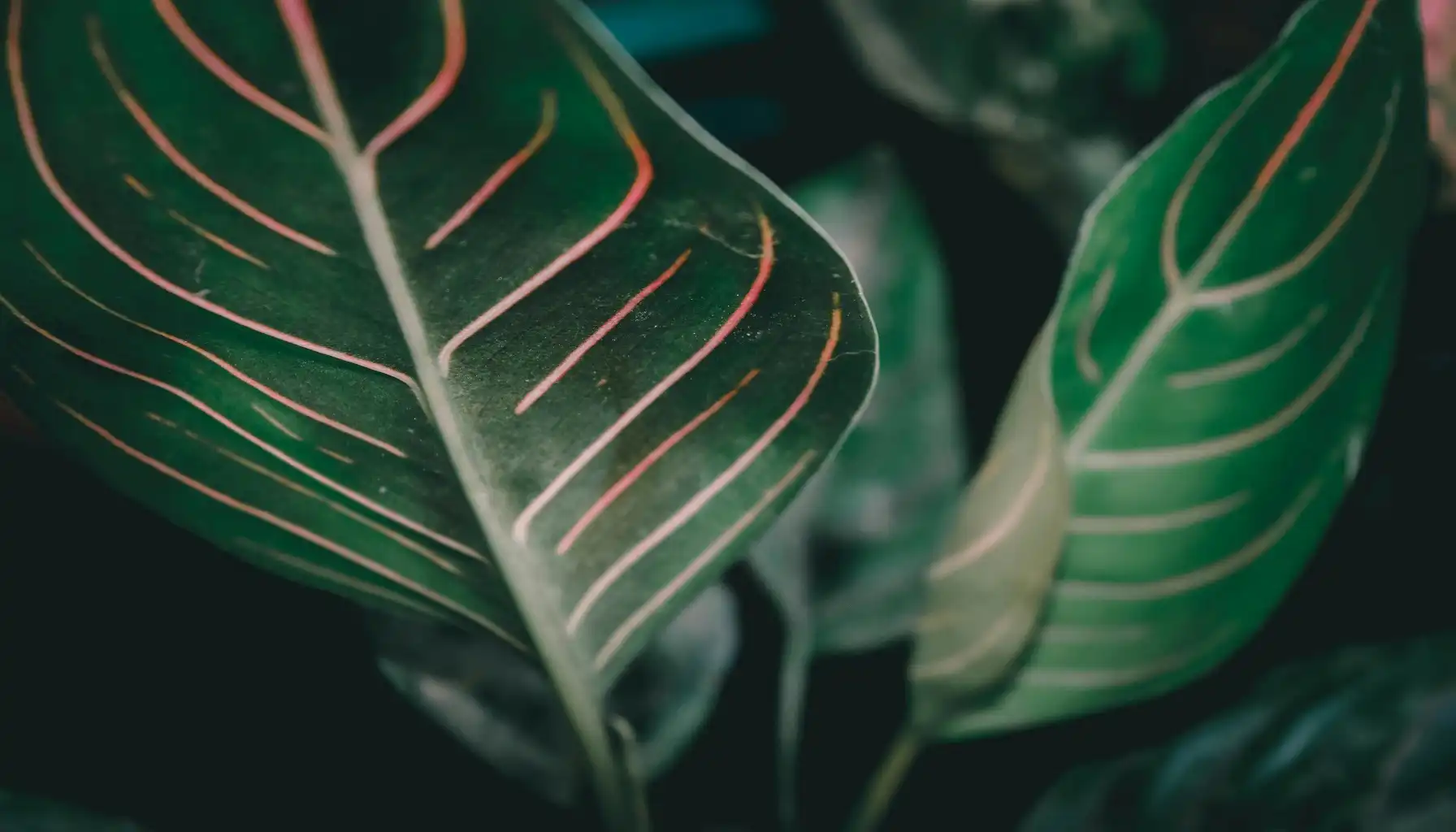Want to add some greenery to your space? Take a look at the Chinese Evergreen plant Aglaonema! With its glossy foliage and striking patterns, it is a great choice for any indoor space.
But beyond aesthetics, the Chinese Evergreen live plant is one of the most beginner-friendly species you can grow right in your home. It is adaptable, low-maintenance, and forgiving for those who don’t like to water often enough.
Let’s learn how to care for a Chinese Evergreen plant with AI Plant Finder to see it flourishing and growing in no time!
Popular Chinese Evergreen Plant Varieties
Variety Name | Leaf Color & Pattern | Light Needs | Special Traits |
Aglaonema ‘Silver Bay’ | Silver center with green edges | Low to medium light | Classic and widely available |
‘Siam Aurora’ Chinese Evergreen Plant | Red-pink tones with green accents | Bright, indirect light | Eye-catching color, great for décor pops |
Aglaonema ‘Maria’ | Deep green with light green streaks | Low light tolerant | Compact, perfect for desks and small spaces |
Aglaonema ‘Cutlass’ | Long, narrow leaves with silvery-green tone | Medium light | Unique shape, elegant vertical growth |
Aglaonema ‘Emerald Beauty’ | Rich green with dark green speckles | Low to medium light | Air-purifying, hardy and low-maintenance |
Aglaonema ‘Golden Bay’ | Golden-green centers with silver margins | Moderate to bright light | Warm-toned, great for neutral interiors |
Origin: Native to the subtropical and tropical forests of Southeast Asia.
Growth Habit: Upright and bushy, usually growing up to 1–3 feet tall indoors.
Lifespan: Long-living and slow-growing with the right care.
Toxicity: Contains calcium oxalate crystals; toxic to pets and humans if ingested.
Despite their different looks, all varieties share a few Chinese Evergreen plant benefits: they thrive in indirect light, don’t mind a bit of neglect, and are champions at adapting to life indoors.
Their foliage remains vibrant year-round, and they ask for very little in return. It makes them ideal companions for both beginners and experienced home gardeners.
Light Requirements: Not Too Bright, Not Too Dim
The green Chinese Evergreen plant prefers the middle ground when it comes to lighting. Their native habitat—tropical forest understories—explains why they do well in filtered light.
Bright, Indirect Light: Ideal for most varieties.
Darker Green Varieties: Tolerate lower light environments, like offices or shaded corners.
Variegated Varieties: Need more light to maintain their beautiful color patterns. Insufficient light causes colors to fade.
Direct Sunlight: Should be avoided, as it can scorch the leaves.
Tip: Rotate your Chinese Evergreen house plant every few weeks to ensure even growth and prevent leaning.
Watering: The Art of “Less Is More”
One of the top mistakes made by worried owners of jungle species is overwatering. The Chinese Evergreen water plant likes to dry out a bit between drinks.
Season | Watering Frequency | What to Check Before Watering |
Spring/Summer | Every 7–10 days (on average) | Soil is dry 2cm below the surface |
Fall/Winter | Every 2–3 weeks | Stem growth slows; less water needed |
Drainage is critical: Always use pots with drainage holes to avoid root rot.
Yellowing leaves: Often a sign of overwatering.
Crispy edges: Could indicate underwatering or dry air.
Tip: Stick your finger into the soil; if it feels dry up to the first knuckle, it’s time to water.
Temperature & Humidity: Keep It Tropical
To mimic their natural rainforest environment and escape Chinese Evergreen plant leaves turning yellow, provide warmth and humidity.
Ways to boost humidity:
Place on a humidity tray with pebbles and water.
Group with other tropical species to create a microclimate.
Use a humidifier, especially in dry indoor climates or winter.
Avoid: Placing near air conditioners, radiators, or drafty windows.
Soil & Feeding: The Right Mix for Strong Roots
The Chinese Evergreen plant flower thrives in a well-draining soil that retains moisture without becoming soggy.
Recommended Soil Mix:
Component | Function |
Peat-free compost | Nutrient-rich and sustainable |
Perlite | Improves drainage and aeration |
Coconut coir | Helps retain moisture without compacting |
Feeding Routine:
Tip: Flush the soil every few months with water to prevent salt buildup from fertilizers that might cause Chinese Evergreen plant yellow leaves. Use AI plant diagnosis tools to see if there are any problems caused by soil quality.
Maintenance Matters: Keep It Clean and Thriving
Regular maintenance keeps your Aglaonema looking its best and functioning well while escaping common issues.
Dust Leaves: Wipe with a damp cloth weekly to allow photosynthesis to occur efficiently.
Prune: Remove dead or yellowing leaves at the base using clean scissors.
Repotting: Every 2–3 years, or when roots begin circling the pot.
Bonus Tip: If your Aglaonema Chinese Evergreen plant begins to look leggy, it might be time to prune and propagate it. Keep reading to know how.
Learning Propagation Techniques: Why and How
If you’ve ever wished you could grow more of your favorite pink Chinese Evergreen plant—or share it with friends—you’re in luck. It is surprisingly easy to propagate!
Even if you are new to home gardening and have no idea about such operations, the methods below will help you expand your indoor jungle (or even share it!) confidently and successfully.
You should know how to propagate Chinese Evergreen plant not only for multiplying it but also for:
Reviving leggy growth by starting fresh from cuttings.
Saving a struggling stem by salvaging healthy sections.
Sharing greenery with friends and family.
Experimenting with water vs. soil rooting methods.
There are three reliable propagation techniques for the plant Chinese Evergreen. Each suits different needs, preferences, and expected growth conditions.
1. Stem Cuttings in Soil
This method is ideal if you want your cutting to root directly in its permanent home. Here’s how to do it:
Materials Needed:
Clean, sharp scissors or pruning shears
Small pot with drainage holes
Well-draining soil (peat-free compost + perlite)
Optional: rooting hormone
Step-by-Step:
Cut a healthy stem about 4–6 inches long. Make sure it includes a few leaves and a node (where leaves meet the stem).
Dip in rooting hormone (optional) to encourage faster root development.
Put the cutting into pre-moistened soil.
Place in bright, indirect light in a warm, humid location.
Mist occasionally and keep the soil lightly moist (but never soggy).
Rooting time: Usually 3–6 weeks.
2. Water Propagation
A popular choice for botany lovers who enjoy watching roots form in real time as a better, more sustainable alternative to Chinese Evergreen plant seeds. Plus, it’s visually satisfying and beginner-friendly.
You’ll Need:
Instructions:
Cut a stem as described above.
Remove lower leaves, leaving only a few at the top.
Place the cutting in a jar with the bottom node submerged in water and leaves above the waterline.
Set the jar in bright, indirect light.
Change water weekly to prevent rot and bacteria buildup.
When roots reach 1–2 inches in length, transplant to soil for long-term growth.
Tip: Use filtered or distilled water if your tap water is high in chlorine or minerals.
3. Division: The Easiest Way to Multiply a Mature Stem
This method works best when your Evergreen Chinese plant is already bushy and has developed “pups” or offshoots at the base.
What You’ll Need:
Gloves
Trowel or small spade
Extra pots
Fresh soil mix
How to Divide:
Gently remove the whole plant from its pot and loosen the soil.
Locate the offshoots or side clusters with their own roots.
Separate them carefully by hand or with a clean blade, ensuring each division has roots attached.
Repot each division in its own raised bed with fresh soil.
Water lightly and keep in a humid, warm spot to reduce transplant shock.
Propagation Method | Best For | Rooting Time | Requires Transplant? |
Stem in Soil | Faster establishment | 3–6 weeks | No |
Water Method | Visual rooting progress | 2–4 weeks | Yes |
Division | Mature stems with pups | Immediate | No |
Aftercare Tips for All Methods:
Humidity is key: Use a humidity dome or plastic bag (loosely placed) to create a greenhouse effect.
Be patient: New growth might take a few weeks to appear.
Don’t fertilize immediately: Wait 4–6 weeks before feeding your new stems.
Propagation is a great way to connect more deeply with your Chinese Evergreen plant pink, learning how it regenerates and thrives. It’s also an opportunity to practice care on a smaller scale—and perhaps create thoughtful gifts for other home-based gardeners.
Is Aglaonema Safe for Pets and Kids?
Unfortunately, no. Chinese Evergreen Silver Bay plant contains insoluble calcium oxalate crystals, which makes Chinese Evergreen plant toxic to cats and can cause adverse reactions if chewed or ingested by humans or animals.
Potential Symptoms:
Group | Common Reactions |
Humans | Mouth irritation, swelling, nausea, difficulty swallowing |
Pets | Excessive drooling, vomiting, pawing at mouth, appetite loss |
While not usually life-threatening, these symptoms are highly uncomfortable and may require medical attention—especially for smaller animals or children.
How to Keep Everyone Safe
Here are some smart safety tips to ensure your plant stays just decorative and never dangerous:
High Placement: Place your Red Chinese Evergreen plant on top shelves, wall-mounted planters, or hanging baskets.
Pet Deterrents: As Chinese Evergreen plant toxic to dogs, try using bitter sprays or citrus peels near the base to discourage nibbling.
Supervise Young Children: Teach them early that greens at your home are for looking, not tasting.
Watch for Chewing Behavior: If pets frequently chew houseplants, consider removing toxic species altogether.
Pet-Friendly Alternatives:
If your household includes pets and you want peace of mind, here are three safer green options that resonate with Chinese Evergreen plant image:
Botanical Name | Safe for Pets | Light Needs | Bonus Feature |
Spider Plant | + | Bright, indirect | Air-purifying and fast-growing |
Boston Fern | + | High humidity | Lush, classic greenery |
Bamboo Palm | + | Medium to bright | Tall and elegant for corners |
But let’s be honest: even the most passionate gardener forgets a watering day or ignores a yellowing leaf now and then. The AI Plant Finder app bridges the gap between intention and execution by delivering timely insights and actions.
Instead of googling symptoms or guessing soil needs, you get real-time, accurate support based on conditions seen through Chinese Evergreen Aglaonema indoor plant photo.
With the right care, a Chinese Evergreen indoor plant becomes a showpiece of your homegrown jungle—lush, colorful, and resilient. But don’t stop at good lighting and watering routines. Go a step further: protect your pets, prevent mistakes, and track its health continuously using the AI Plant Finder.
By blending nature and technology, you create a space where plants and people (and even pets) thrive together—harmoniously.
Your plant journey doesn’t need to be perfect—it just needs to be informed. And now, it is.
Related AI Plant Finder Posts:







